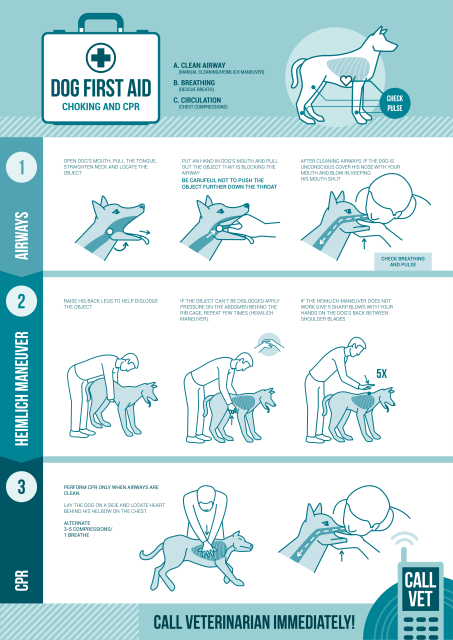When we first started overlanding with our two young children, we had limited space, time, and money. Let’s face it; it is a difficult transition from the comforts of a large home to full-time, vehicle-dependent travel, and that challenge alone was enough for us to decide not to travel with a pet. Fast forward 10 years and the kids are moving on with their lives, looking to fly the coop. As parents who have loved having our kids around 24 hours a day for over 3,650 days, we need to fill that emotional gap; that is exactly what our dog, Chewbacca (Chewie), has done.

After almost three years of Chewie bringing joy to our lives (while simultaneously terrorizing us, people wearing black boots, birds, animals, and, well, anything that has a heartbeat), we realize that he probably would have been a positive addition to our family from the start. Perhaps having a pet might have made for an easier transition, reminding us of a “home life.” A pet will keep your children entertained and busy outdoors for hours on end and will be a great way for children to make friends. For the more mature couple, a pet fills a void, perhaps of their children or grandchildren. I wish I had adopted a rescue sooner. Who doesn’t need a furry cuddle of unconditional love in their lives?
We have learned that living on the road with a pet completely changes your style of travel, but, as with everything in life, there are pros and cons. Gone are the days of having a Sunday lie-in, visiting a nature reserve, having a full day of sightseeing in a city, and eating a guilt-free meal. Yes, you can still do all of the above but with a lot more planning and consideration for another being. You can always find a friendly sitter or a kennel if you want to tour for a day. Your pet might thank you for the social time if they do not suffer from separation anxiety.
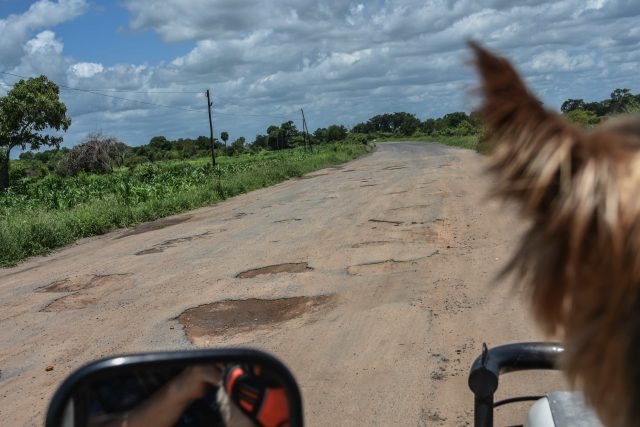
An active pet keeps you moving, and in the last few years, we have visited more parks, hiked more often, and taken a break on the road more frequently. Our boy has compelled us to take the time to get back to nature in an interactive way, and we absolutely love it. No longer can we sit on a camp chair and merely observe nature; we now must smell every blade of grass, inspect every rock, and chase every lizard.
There are many aspects of traveling with a pet that you should take into consideration before taking the leap and adopting one.
Disclaimer: Please do not use this guide as a substitute for professional assistance or the recommendations of your veterinarian.
Size Matters
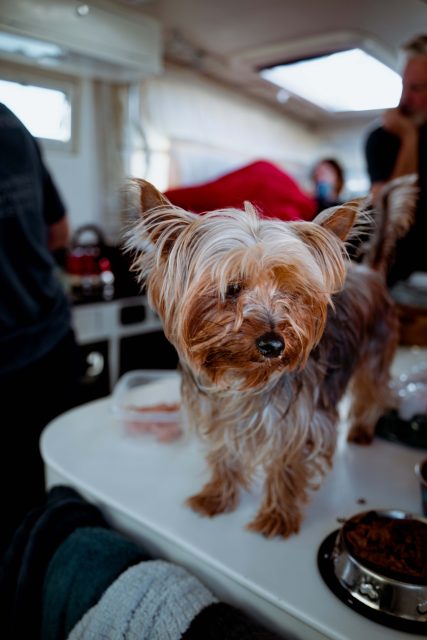
Image Credit: Jorge Gonzalez
A large dog takes up a lot of room, and your rig will have to accommodate them. Sitting in an uncomfortable space for many hours on end is extremely bad for an animal’s posture and, inevitably, their mood.
A small dog takes up very little space but, depending on their breed and temperament, can bark a lot, be ankle biters, or become possessive. While a small dog offers excellent security by being alert and observant, a larger dog may offer physical protection, an important consideration for some travelers. However, an aggressive dog is a liability, and the one possible negative of adopting a rescue animal as it may come with “baggage.” Our dog certainly did.
Paperwork and Bureaucracy
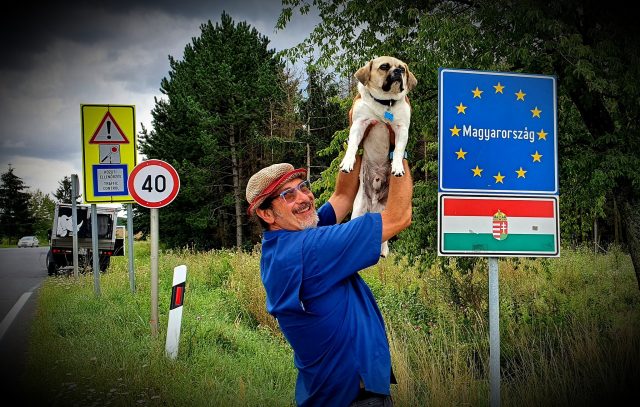
Image Credit: Chris Ratay
Obtain a Pet Passport
A pet passport is available in the EU and the USA and will make it easier for your pet to travel internationally. The passport reflects relevant vaccinations, deworming, and flea and tick prevention administered before traveling.
Health Certificate for International Travel
Most countries require a health certificate to be completed by a local veterinarian, and it must be attested by the state vet of the country of departure. The cost of this consultation and certificate ranges between $25 and $100.
Rabies Titer Test
A rabies titer test will be required in some countries such as Hawaii (if the pet is not from the USA mainland), Australia, New Zealand, Japan, Singapore, and Hong Kong. Blood analysis is performed by certified laboratories; therefore, the cost of the titer test can range between $40 and $150.
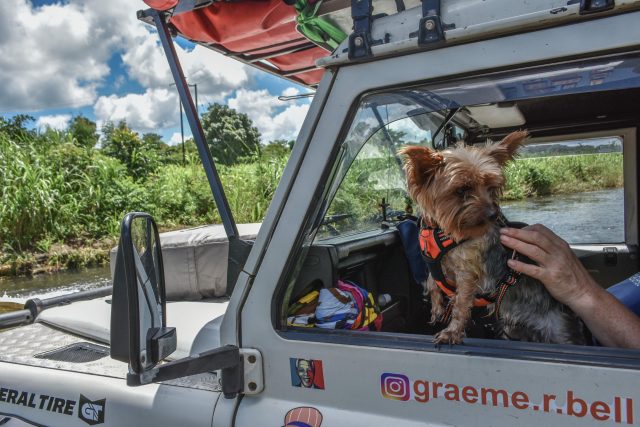
Vaccinations are required for travel
Required Vaccinations
- Rabies
- Parvovirus
- Kennel cough
- Hepatitis
- The DHPP vaccine (distemper, hepatitis, parvovirus, and parainfluenza) is the best for overall protection when traveling and is usually effective for three years.
Flights
Traveling overland usually requires a flight to another continent or even crossing the Darién Gap, which, unfortunately, cannot be done by land. Take note of the following.
- When you are ready to reserve your flight/s, ensure you have all relevant information on hand before calling the airline. It might be cheaper to book online, but you will always need to ensure that there is space on the flight for your pet, hence an annoying phone call. Most airlines only allow between one and five pets per flight.
- Only legally trained and registered service animals are permitted on flights for free. In some instances, an emotional support animal (ESA) is allowed, but more airlines are banning ESAs as some people take advantage of the system. Your goat may be registered as an ESA, but it will most certainly not fly in the cabin.
- The cost for the flight of your pet (except for legally trained service animals) can range from $100 to $500, depending on whether your pet will be transported via cabin or cargo. Each airline has different costs for national and international flights.
- You can bring along small dogs, cats, and most household birds in the cabin, as long as they fit in the stipulated carrier size and go under your seat. Most carriers are 17 inches long x 12 inches wide x 7 inches high.
- Many airlines will only transport a pet older than eight weeks and weighs no more than 10 pounds. Please confirm the correct size and weight limitation with your airline prior to travel.
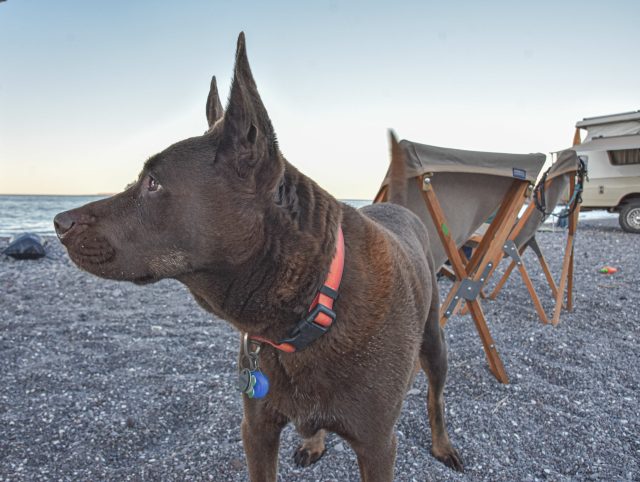
- Pet carriers can either be hard or soft-sided, but confirm this with the specific airline. We fly with a soft-sided carrier that can be used as Chewie’s bed when on the road. Acquaint and familiarize your pet with the carrier before flying, as this must be considered a safe space for them. Perhaps have a soft blanket to line the bottom of the carrier that smells of their favorite person. Many airlines don’t allow more than a blanket, liner, and food and water to be in the carrier when flying. A carrier that can be carried as a backpack works great for touring around cities on a bicycle or bus.
- Certain types of breeds cannot fly. Snub-nosed and short-nosed pets such as Pugs or Persian cats require special permission to fly on an airplane, and finding an airline that will take the risk will be difficult if not near impossible.
- It is highly recommended not to sedate your pet before travel. Firstly the airline will not transport them if they are sedated, and secondly, your pet is more likely to suffer heart or respiratory problems during the flight. Consider asking your veterinarian to prescribe something for anxiety, such as Xanax or a preferred herbal option.
- Try not to feed your pet two hours before flying. Just as you may feel nauseous between take-off and landing, your pet does too. Make sure you have a small pad for when your pet needs a bathroom break. They will have to relieve themselves in their carrier, as you may not remove them at any time. For flights over four hours, water is recommended. Ensure that their water container is securely fastened if traveling via cargo; a small bowl or syringe of water is suitable for a pet flying in a cabin.
- Ensure that you travel with your pet during the correct season or at least when it will be a comfortable temperature. Many airlines won’t transport animals when the temperature falls below 7°C/45°F or rises higher than 29°C/85°F.
- Many pet owners are extremely concerned about their pets traveling in cargo, and rightly so, but remember that all kinds of wildlife are transported daily across the world on airplanes, and at a rate of 0.40 incidents per 100,000 animals transported per year, it’s evident that many animals come out unscathed on the other side. Follow all the rules for their safe passage via cargo, and your pet will be better off.
- If you have the money and would like to travel with your pets, you can also share a chartered jet to get you to your destination without any hassle. More and more people are opting for this personalized service when relocating; keep in mind that a Trans-Atlantic flight from the USA to Europe can easily set you back $7,000 for a one-way flight.
Dealing with Stray Animals
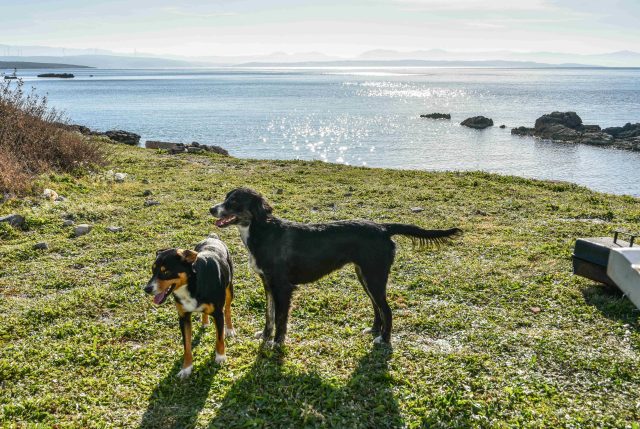
There are many strays across the globe, particularly in the Global South. It is always a risk to have your pet walking off-leash in any area where there are strays. Your dog might not be aggressive, but the stray may be looking for a fight. Carry a tin or can with some coins in it. If one tries to attack, the action and noise alone should frighten them off. Alternatively, use a walking stick. Not to harm the dog but to herd him away from your family. A simple gesture of pointing the stick at the dog should send the signal that he is not to cross your path. Some stray dogs are friendly and only want a feed. You may allow your dog to interact, but bear in mind that the stray animal will most certainly carry ticks, fleas, and the diseases of neglect. We prefer not to let the dogs interact in most cases but are sure to feed the strays and offer them water. We have seen stray dogs on the beach in Mexico devour five liters of fresh water in one sitting. Try to leave strays healthier than when you find them, and a squirt of tick and flea treatment on the neck may even save their lives.
Dealing with Emergencies
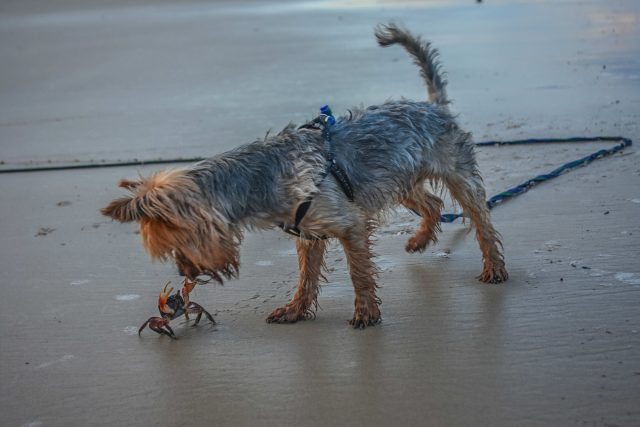
Whenever we are in an area longer than a day or two, we always familiarize ourselves with the closest hospitals and veterinarians. If an emergency arises, it will be quicker to recall this information than suddenly searching high and low for the hospital. Prevention is better than cure, and keeping an eye on your dog at all times is advisable. First Aid should be administered calmly to stabilize the animal before transportation.
Pet Insurance

If traveling through the USA, it’s advisable to buy pet insurance as vet fees are astronomical; one emergency and your month’s budget is blown. Some pet insurance companies cover your pet when you travel but be sure to read the fine print. Many insurance companies will do their best not to settle a bill, so make sure you cross your i’s and dot your t’s.
Food
- Most large grocery stores stock regular brand names such as Purina and Pedigree.
- If your dog is on a special diet, try and take along as much pet food as possible. Specialist foods can be found at some pet stores but more so at veterinary offices.
- If you run out of your favorite pet food or are trying a new diet, take note of all the ingredients. In some countries, meat is inexpensive, and a raw diet might benefit your dog. Just remember that pork is an absolute no in general (cooked or uncooked), and chicken is an absolute no on the raw diet.
- We found that healthy treats are scarce in many countries unless you intend to bake or make your own, and you may need to stock up on your pet’s favorite treats when they are available.
- Ensure that you brush your dog’s teeth daily. If they don’t enjoy the brushing, take a pea-sized amount and rub it onto their teeth and gums with your fingers. And please use dental toothpaste specific to dogs. This will save you money on teeth cleaning that can cost $150 and upwards, and it will prolong your dog’s life as they get older.
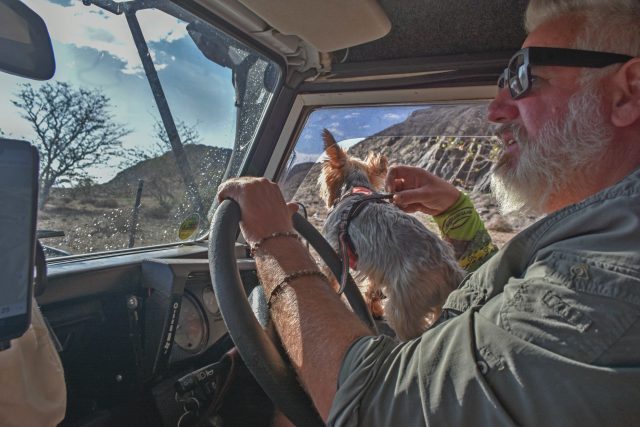
CBD Oil
I use CBD oils to calm Chewie, but make sure to administer it to pets within 30 minutes to an hour before an event and dose your pet correctly. Too much, and your pet will be nervous and agitated. Please note that CBD is not legal in many countries, so be careful when crossing borders with any CBD/THC products. We arrived in Mexico with CBD treats, and the airport security dogs sniffed them out immediately, which led to a traumatic encounter with a corrupt agricultural official.
Parks and Meetups
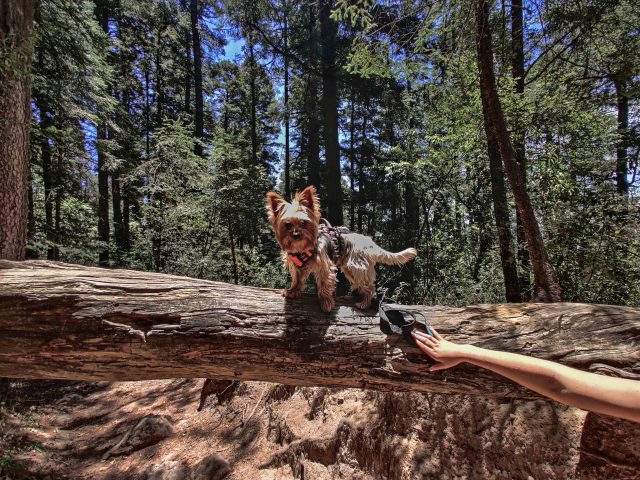
If traveling with one pet, they will get lonely, and there is no better way to keep your dog socialized than by visiting the local dog park. Make sure you are familiar with the park’s rules, e.g., keeping your dog on a leash, picking up behind them, and just general etiquette.
Dangerous Foods and Plants
Our dog is tiny, and at 4 kilograms or 8-pounds, even a small amount of chocolate will make him gravely ill. Larger dogs are naturally more resilient.
We pay careful attention to what our dog can and can’t eat, and yes, the list is quite extensive.
Medical Kit
Like it or not, your pet is like a child; they get sick, hurt, and sometimes can’t let you know where or how badly. These are essential items to treat pets for minor ailments:
- Dewormer – you should give your pet a dewormer every three months as they will come into contact with other animals’ feces or infected fleas
- Tick and flea treatment – This depends entirely on the treatment. We always have Bravecto on hand; it’s quick and easy to administer, doesn’t burn or irritate my pet’s skin, and lasts for three months. There are many products on the market, but please, once again, read the ingredients to ensure that there are no contaminants that are harmful to your pet
- Gauze
- Cotton wool balls
- Nonstick bandages
- Scissors
- Tweezers
- Hydrogen peroxide is an effective way to clean wounds, but should your dog ingest something toxic; it will also help induce vomiting
- Activated charcoal – This is ideal if your pet consumes something poisonous such as an innocent-looking cane toad
- Non-toxic antimicrobial hydrogel – Great for cuts, rashes, and sores, and is not dangerous to your pet if ingested
- Digital thermometer
- Syringes to either administer medicine or to flush a wound
- Anti-diarrhea paste for dogs
- Electrolytes for dogs – it is safe to use Pedialyte or similar to treat your pet.
Many of the above items should already be available in your medical kit.
I have attached a self-explanatory picture of the emergency procedure for a choking dog:
Image Source: Shutterstock
The Importance of Training and Training Apps
When you adopt a rescue, it’s difficult to know what type of traumatic experiences they went through before spending sufficient time with them. Once you have identified the animal’s needs, you have to train it out of them, which is perhaps easier said than done. We adopted our Chewie under the impression that he was to be a lap dog. He is the opposite—aggressive to anyone he doesn’t instantly like (especially those wearing uniforms and workwear, but never police or military, strangely). He lunges and barks at other dogs, and he is a hunter.

We are still trying to train these traits out of him, but it has been a challenge. Traveling constantly changes their safe space, and they then have to learn to protect their “home,” which is now a traveling home on wheels with a constantly changing environment. If your pet has already been trained and is not territorial, possessive, aggressive, or temperamental, little training may be required to get them accustomed to their ever-changing landscapes.
The training of you, the human, is far more critical than the training of the dog. If you are not consistent and disciplined, you cannot expect your animal to be. Sending a dog to a trainer will solve nothing if the trainer does not train you.
These are simple commands that your pet needs to know, such as:
- Its name
- Sit
- Come
- Stay
- Leave it
If you’re keen on training your dog yourself, these three channels are my favorite.
I love watching Zak Georg’s Dog Training videos on YouTube. Some of the instruction videos are not applicable, such as house training and dog proofing your home. But he has a very likable demeanor and is not aggressive in his training.
Will Atherton Academy guides you through the entire training process for each lesson. Need to learn how to walk with your dog off-leash? He leads you through the whole three-week course. He also mentions when the dog has already been trained, something most trainers fail to mention in their videos.
Then there is Cesar Millan, who is world-renowned, and although I love watching his videos, he seems to provide the initial diagnosis of what training the dog requires, a short snippet of the training process, and voilà, the dog is trained. It is not a step-by-step guide on how to remedy these problems at home or on the road.
In summary, having a dog on the road with us has presented many challenges and unforeseen expenses, but he is now a member of the family, and we could not imagine life without him.
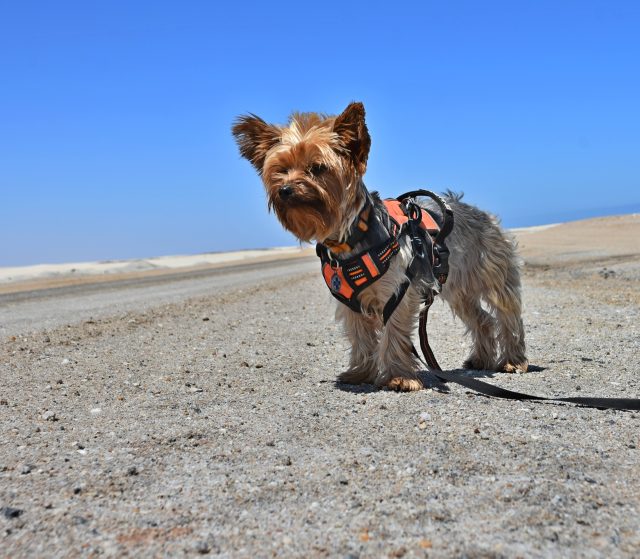
Resources
- Pupford Dog Training App by Zak George – 30-day training program
- Puppr Dog Training and Tricks by Sara Carson – loads of lessons and tricks
- Dogo – loads of activities and games, and you can also connect with trainers for a fee
- GoodPup – this is a paid app with qualified trainers
- BarkHappy – a social networking app with maps of local vets and pet-friendly stores. Unfortunately, I found this only worked while in the USA.
If you’re interested in training your dog as a service animal, therapy animal, or emotional support dog, then the SDTSI app is for you.
We have interviewed several overlanders that travel with pets and in the coming weeks they will share their stories with us, along with why they choose to travel with a pet, whether adoption while on the road is a great idea and tips and tricks to overlanding with a pet.
Our No Compromise Clause: We carefully screen all contributors to ensure they are independent and impartial. We never have and never will accept advertorial, and we do not allow advertising to influence our product or destination reviews.



